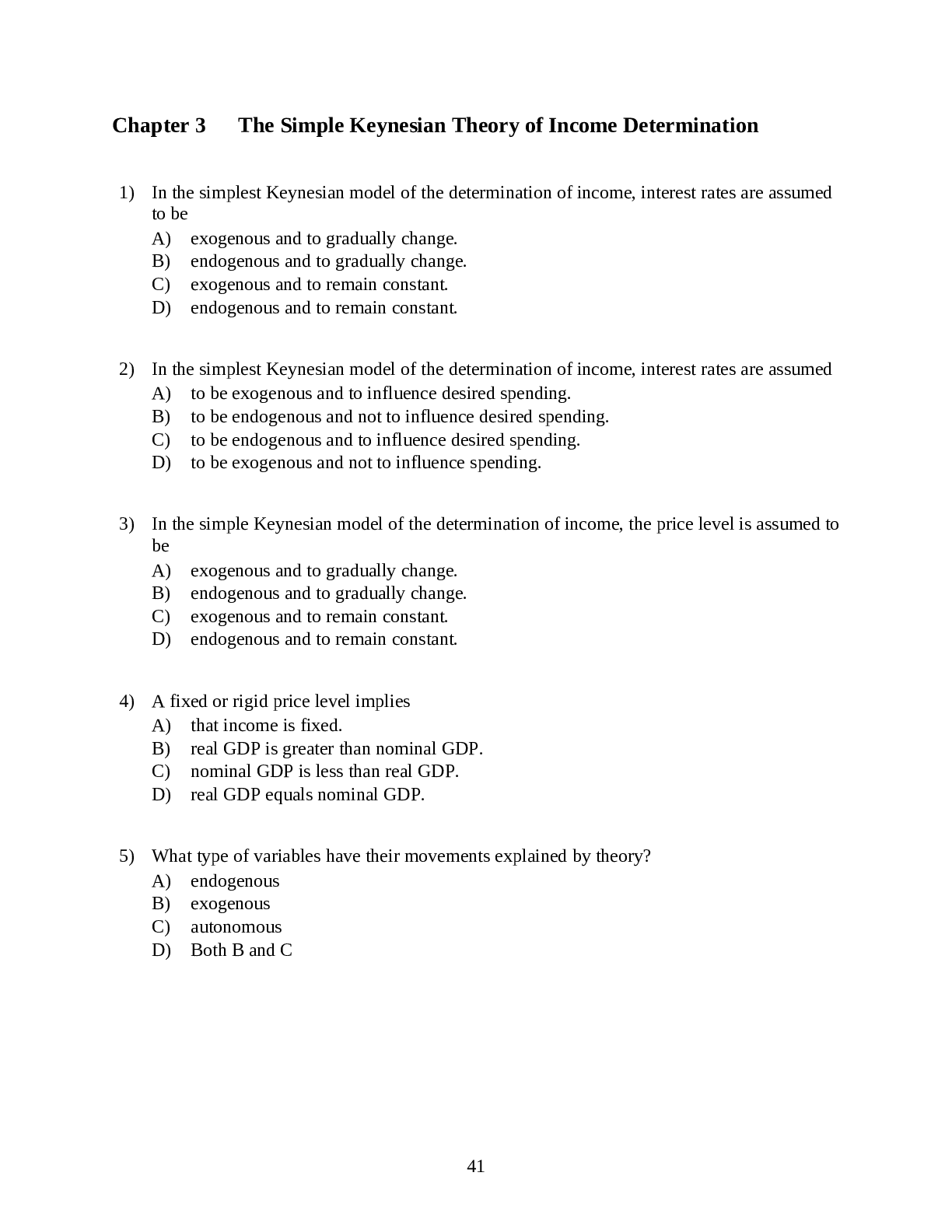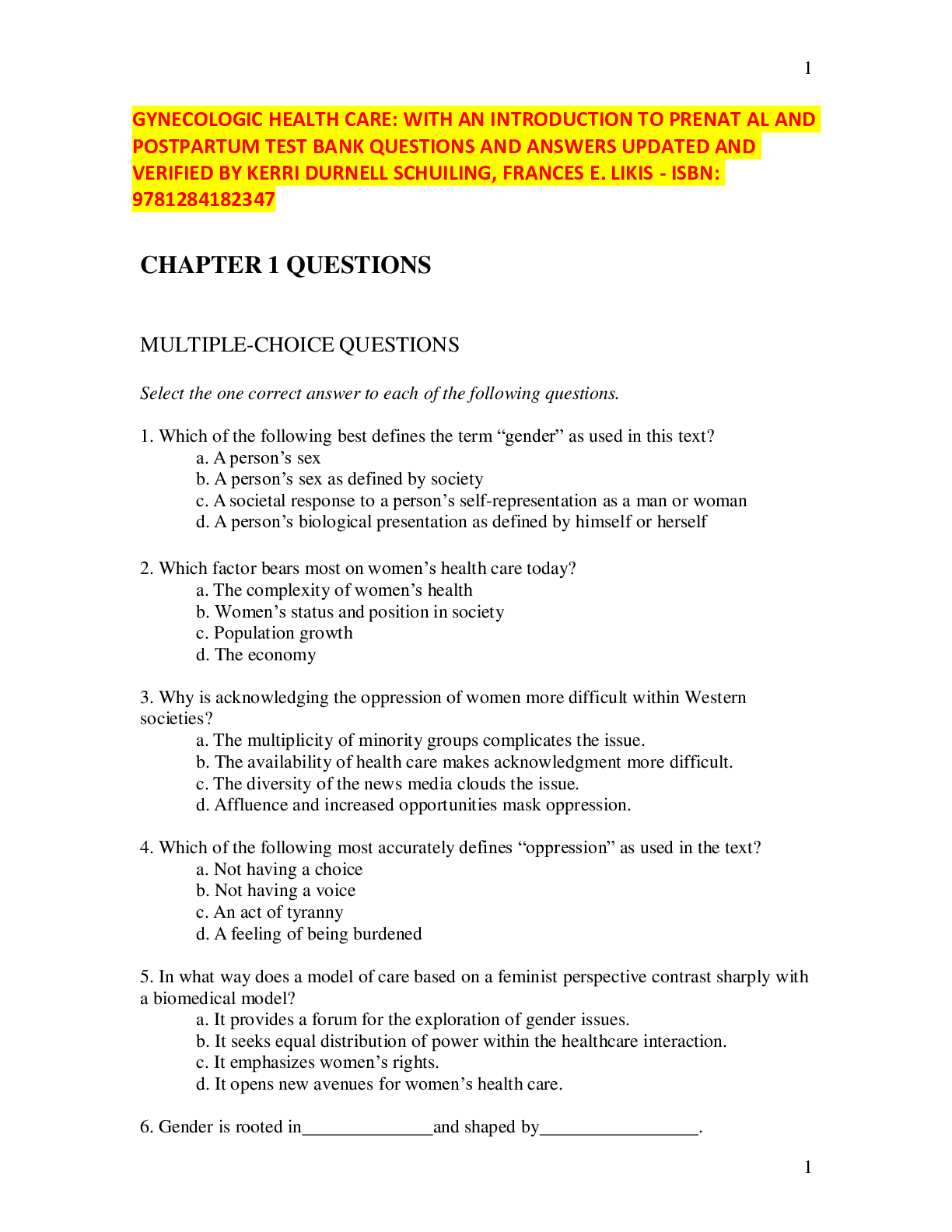*NURSING > TEST BANK > Chamberlain College of Nursing NR508 test bank pharmacology > CHAPTER 1 - 73 ( 224 PAGES ) (All)
Chamberlain College of Nursing NR508 test bank pharmacology > CHAPTER 1 - 73 ( 224 PAGES )
Document Content and Description Below
Chapter 01: Prescriptive Authority and Role Implementation: Tradition vs. Change Test Bank MULTIPLE CHOICE 1. Which of the following has influenced an emphasis on primary care education in medical ... schools? a. Changes in Medicare reimbursement methods recommended in 1992 b. Competition from nonphysicians desiring to meet primary care shortages c. The need for monopolistic control in the marketplace of primary outpatient care d. The recognition that nonphysicians have variable success providing primary care ANS: A The Physician Payment Review Commission in 1992 directly increased financial reimbursement to clinicians who provide primary care. Coupled with a shortage of primary care providers, this incentive led medical schools to place greater emphasis on preparing primary care physicians. Competition from nonphysicians increased coincidentally as professionals from other disciplines stepped up to meet the needs. Nonphysicians have had increasing success at providing primary care and have been shown to be safe and effective. DIF: Cognitive Level: Remembering (Knowledge) REF: 2 2. Which of the following statements is true about the prescribing practices of physicians? a. Older physicians tend to prescribe more appropriate medications than younger physicians. b. Antibiotic medications remain in the top five classifications of medications prescribed. c. Most physicians rely on a “therapeutic armamentarium” that consists of less than 100 drug preparations per physician. d. The dominant form of drug information used by primary care physicians continues to be that provided by pharmaceutical companies. ANS: D Even though most physicians claim to place little weight on drug advertisements,pharmaceutical representatives, and patient preference and state that they rely on academic sources for drug information, a study showed that commercial rather than scientific sources of drug information dominated their drug information materials. Younger physicians tend to prescribe fewer and more appropriate drugs. Antibiotics have dropped out of the top five classifications of drugs prescribed. Most physicians have a therapeutic armamentarium of about 144 drugs. DIF: Cognitive Level: Remembering (Knowledge) REF: 3 3. As primary care nurse practitioners (NPs) continue to develop their role as prescribers of medications, it will be important to: a. attain the same level of expertise as physicians who currently prescribe medications. b. learn from the experiences of physicians and develop expertise based on evidencebased practice. c. maintain collaborative and supervisorial relationships with physicians who will oversee prescribing practices. d. develop relationships with pharmaceutical representatives to learn about new medications as they are developed. ANS: B As nonphysicians develop the roles associated with prescriptive authority, it will be important to learn from the past experiences of physicians and to develop prescribing practices based on evidence-based medicine. It is hoped that all prescribers, including physicians and nurse practitioners, will strive to do better than in the past. NPs should work toward prescriptive authority and for practice that is not supervised by another professional. Pharmaceutical representatives provide information that carries some bias. Academic sources are better. DIF: Cognitive Level: Applying (Application) REF: 4 Chapter 02: Historical Review of Prescriptive Authority: The Role of Nurses (NPs, CNMs, CRNAs, and CNSs) and Physician Assistants Test Bank MULTIPLE CHOICE 1. A primary care NP will begin practicing in a state in which the governor has opted out of the federal facility reimbursement requirement. The NP should be aware that this defines how NPs may write prescriptions:a. without physician supervision in private practice. b. as CRNAs without physician supervision in a hospital setting. c. in any situation but will not be reimbursed for this by government insurers. d. only with physician supervision in both private practice and a hospital setting. ANS: B In 2001, the Centers for Medicare and Medicaid Services changed the federal physician supervision rule for CRNAs to allow state governors to opt out, allowing CRNAs to write prescriptions and dispense drugs without physician supervision. DIF: Cognitive Level: Understanding (Comprehension) REF: 9 2. CRNAs in most states: a. must have a Drug Enforcement Administration (DEA) number to practice. b. must have prescriptive authority to practice. c. order and administer controlled substances but do not have full prescriptive authority. d. administer medications, including controlled substances, under direct physician supervision. ANS: C Only five states grant independent prescriptive authority to CRNAs. CRNAs do not require prescriptive authority because they dispense a drug immediately to a patient and do not prescribe. Without prescriptive authority, they do not need a DEA number. DIF: Cognitive Level: Understanding (Comprehension) REF: 9 3. A CNM: a. may treat only women. b. has prescriptive authority in all 50 states. c. may administer only drugs used during labor and delivery. d. may practice only in birthing centers and home birth settings. ANS: BCNMs have prescriptive authority in all 50 states. They may treat partners of women for sexually transmitted diseases. They have full prescriptive authority and are not limited to drugs used during childbirth. They practice in many other types of settings. DIF: Cognitive Level: Remembering (Knowledge) REF: 9 4. In every state, prescriptive authority for NPs includes the ability to write prescriptions: a. for controlled substances. b. for specified classifications of medications. c. without physician-mandated involvement. d. with full, independent prescriptive authority. ANS: B All states now have some degree of prescriptive authority granted to NPs, but not all states allow authority to prescribe controlled substances. Many states still require some degree of physician involvement with certain types of drugs. DIF: Cognitive Level: Understanding (Comprehension) REF: 12 5. The current trend toward transitioning NP programs to the doctoral level will mean that: a. NPs licensed in one state may practice in other states. b. full prescriptive authority will be granted to all NPs with doctoral degrees. c. NPs will be better prepared to meet emerging health care needs of patients. d. requirements for physician supervision of NPs will be removed in all states. ANS: C The American Association of Colleges of Nursing has recommended transitioning graduate level NP programs to the doctoral level as a response to changes in health care delivery and emerging health care needs. NPs with doctoral degrees will not necessarily have full prescriptive authority or be freed from requirements about physician supervision because those are subject to individual state laws. NPs will still be required to meet licensure requirements of each state. DIF: Cognitive Level: Understanding (Comprehension) REF: 12 6. An important difference between physician assistants (PAs) and NPs is PAs: a. always work under physician supervision. b. are not required to follow drug treatmentprotocols. c. may write for all drug categories with physician co-signatures. d. have both inpatient and outpatient independent prescriptive authority. ANS: A PAs commonly have co-signature requirements and work under physician supervision. DIF: Cognitive Level: Understanding (Comprehension) REF: 17 Chapter 03: General Pharmacokinetic and Pharmacodynamic Principles Test Bank MULTIPLE CHOICE 1. A primary care nurse practitioner (NP) prescribes a drug to an 80-year-old AfricanAmerican woman. When selecting a drug and determining the correct dose, the NP should understand that the knowledge of how age, race, and gender may affect drug excretion is based on an understanding of: a. bioavailability. b. pharmacokinetics. c. pharmacodynamics. d. anatomy and physiology. ANS: B Pharmacokinetics is the study of the action of drugs in the body and may be thought of as what the body does to the drug. Factors such as age, race, and gender may change the way the body acts to metabolize and excrete a drug. Bioavailability refers to the amount of drug available at the site of action. Pharmacodynamics is the study of the effects of drugs on the body. Anatomy and physiology is a basic understanding of how the body functions. DIF: Cognitive Level: Understanding (Comprehension) REF: 21 2. A patient asks the primary care NP which medication to use for mild to moderate pain. The NP should recommend: a. APAP. b. Tylenol. c. acetaminophen. d. any over-the-counter pain product. ANS: C Providers should use generic drug names when prescribing drugs or recommending themto patients, unless a particular brand is essential for some reason. Because acetaminophen can have many trade names, it is important for patients to understand that the drug is the same for all to avoid overdosing on acetaminophen. APAP is a commonly used abbreviation but should not be used when recommending the drug to patients. DIF: Cognitive Level: Applying (Application) REF: 21 3. A patient wants to know why a cheaper version of a drug cannot be used when the primary care NP writes a prescription for a specific brand name of the drug and writes, “Dispense as Written.” The NP should explain that a different brand of this drug: a. may cause different adverse effects. b. does not necessarily have the same therapeutic effect. c. is likely to be less safe than the brand specified in the prescription. d. may vary in the amount of drug that reaches the site of action in the body. ANS: D Different formulations of the same drug may have varying degrees of bioavailability, and it may be important to stick to a particular brand for drugs with narrow therapeutic ranges. All drugs with similar active ingredients should have the same therapeutic actions and side effects and should be equally safe. DIF: Cognitive Level: Applying (Application) REF: 22 4. A primary care NP wishes to order a drug that will be effective immediately after administration of the drug. Which route should the NP choose? a. Rectal b. Topical c. Sublingual d. Intramuscular ANS: C The sublingual route is preferred for quick action because the drug is directly absorbed into the bloodstream and avoids the pass through of the liver, where much of an oral drug is metabolized. Rectal routes have unpredictable absorption rates. Topical routes are the slowest. Intramuscular routes are slow. DIF: Cognitive Level: Remembering (Knowledge) REF: 22 5. A patient receives an inhaled corticosteroid to treat asthma. The patient asks the primary care NP why the drug is given by this route instead of orally. The NP should explain that the inhaled form:a. is absorbed less quickly. b. has reduced bioavailability. c. has fewer systemic side effects. d. provides dosing that is easier to regulate. ANS: C An inhaled corticosteroid goes directly to the site of action and does not have to pass through gastrointestinal tract absorption or the liver to get to the lungs. It is generally well absorbed at this site, although dosing is not necessarily easier to regulate because it is not always clear how much of an inhaled drug gets into the lungs. DIF: Cognitive Level: Applying (Application) REF: 21 6. A patient takes an oral medication that causes gastrointestinal upset. The patient asks the primary care NP why the drug information insert cautions against using antacids while taking the drug. The NP should explain that the antacid may: a. alter drug absorption. b. alter drug distribution. c. lead to drug toxicity. d. increase stomach upset. ANS: A Changing the pH of the gastric mucosa can alter the absorption of the drug. Drug distribution is not affected. It may indirectly cause drug toxicity if a significant amount more of the drug is absorbed. It would decrease stomach upset. DIF: Cognitive Level: Applying (Application) REF: 22 7. A patient will begin taking two drugs that are both protein-bound. The primary care NP should: a. prescribe increased doses of both drugs. b. monitor drug levels, actions, and side effects. c. teach the patient to increase intake of protein. d. stagger the doses of drugs to be given 1 hour apart. ANS: B Protein-bound drugs bind to albumin, and serum albumin levels may affect how drugs are distributed. The provider should monitor drug levels, actions, and side effects and change dosing accordingly. Increasing the dose of both drugs is not recommended unless monitoring indicates. Increasing dietary protein does not affect this. Staggering the drugswill not affect this. DIF: Cognitive Level: Applying (Application) REF: 25 8. A patient is taking drug A and drug B. The primary care NP notes increased effects of drug B. The NP should suspect that in this case drug A is a cytochrome P450 (CYP450) enzyme: a. inhibitor. b. substrate. c. inducer. d. metabolizer. ANS: A If drug A is a CYP450 enzyme inhibitor, it decreases the capacity of the enzyme to metabolize drug B, causing more of drug B to be available. A substrate is a drug acted on by the enzyme. If drug B is an enzyme inducer, it would cause increased metabolism of drug A. DIF: Cognitive Level: Applying (Application) REF: 26 - 27 9. The primary care NP should understand that a drug is at a therapeutic level when it is: a. at peak plasma level. b. past 4 or 5 half-lives. c. at its steady plasma state. d. between minimal effective concentration and toxic levels. ANS: D The therapeutic range of a drug is the area between the minimal effective concentration and the toxic concentration. Peak plasma level is the highest level the drug reaches and may be well into the toxic range. Steady state occurs when there is a stable concentration of the drug and generally occurs after 4 or 5 half-lives. DIF: Cognitive Level: Applying (Application) REF: 31 10. A primary care NP is preparing to prescribe a drug and notes that the drug has nonlinear kinetics. The NP should: a. monitor frequently for desired and adverse effects. b. administer a much higher initial dose as a loading dose. c. monitor creatinine clearance at baseline and periodically.d. administer the drug via a route that avoids the first-pass effect. ANS: A Drugs with nonlinear kinetics are not eliminated based on dose or concentration of the drug, and these drugs have a narrow therapeutic window and must be monitored closely for desired effects and toxicity. DIF: Cognitive Level: Applying (Application) REF: 32 11. A primary care NP is prescribing a drug for a patient who does not take any other medications. The NP should realize that: a. CYP450 enzyme reactions will not interfere with this drug’s metabolism. b. substrates such as alcohol cannot interfere with the drug when the patient is abstaining. c. food-drug interactions are limited to those where food enhances or inhibits drug absorption. d. a thorough history of diet, alcohol use, smoking, and over-the-counter and herbal products is required. ANS: D Drugs are not the only substances that interfere with drug kinetics and dynamics. The primary care NP should conduct a thorough history of food and alcohol intake, smoking, and over-the-counter and herbal supplements to identify things that might interfere with a drug. All of these may interfere with CYP enzymes. Alcohol intake can influence this even when the patient is abstaining because of long-term effects on the liver. DIF: Cognitive Level: Understanding (Comprehension) REF: 38-39 Chapter 04: Special Populations: Geriatrics Test Bank MULTIPLE CHOICE 1. A nurse practitioner (NP) is considering a possible drug regimen for an 80-year-old patient who reports being forgetful. To promote adherence to the regimen, the NP should: a. select drugs that can be given once or twice daily. b. provide detailed written instructions for each medication.c. order medications that can be given on an empty stomach. d. instruct the patient to take a lower dose if side effects occur. ANS: A To promote adherence in elderly patients, selecting the smallest number of medications with the simplest dose regimens is recommended, with once-daily dosing preferred. Instructions should be simplified. Drug dosing should be timed with mealtimes to help patients remember to take them. Lower dosing may be necessary with some drugs, but patients should not do this without consulting their provider. DIF: Cognitive Level: Applying (Application) REF: 57 - 58 2. A 75-year-old patient who lives alone will begin taking a narcotic analgesic for pain. To help ensure patient safety, the NP prescribing this medication should: a. assess this patient’s usual sleeping patterns. b. ask the patient about problems with constipation. c. obtain a baseline creatinine clearance test before the first dose. d. perform a thorough evaluation of cognitive and motor abilities. ANS: D The body system most significantly affected by increased receptor sensitivity in elderly patients is the central nervous system, making this population sensitive to numerous drugs. It is important to evaluate motor and cognitive function before beginning drugs that affect the central nervous system to minimize the risk of falls. Assessment of sleeping patterns is important, but not in relation to patient safety. It is not necessary to evaluate stool patterns or renal function. DIF: Cognitive Level: Applying (Application) REF: 50| 55 3. A thin 90-year-old patient who will begin taking warfarin has experienced a recent weight loss of 15 pounds. The NP caring for this patient should: [Show More]
Last updated: 1 year ago
Preview 1 out of 224 pages
Instant download

Buy this document to get the full access instantly
Instant Download Access after purchase
Add to cartInstant download
Reviews( 0 )
Document information
Connected school, study & course
About the document
Uploaded On
Aug 06, 2021
Number of pages
224
Written in
Additional information
This document has been written for:
Uploaded
Aug 06, 2021
Downloads
0
Views
33





.png)







